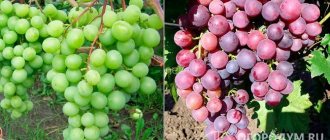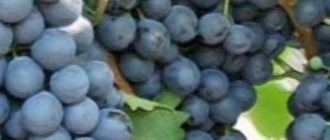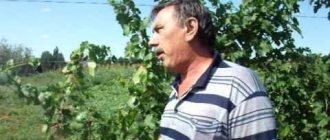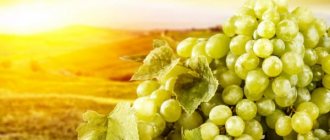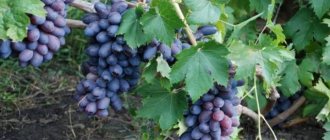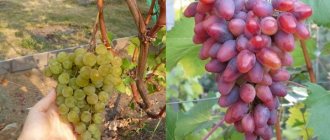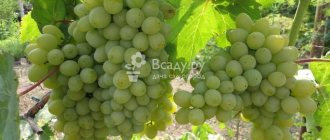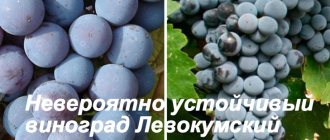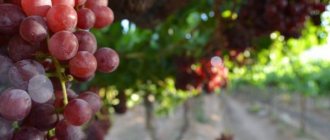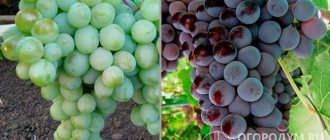Description and characteristics of the grape variety "Agatam"
| Selection | “Donskoy agate” and “Amur” |
| Ripening period | Medium (115-120 days) |
| Bunch weight | 500-600 g. |
| Berry weight | 3-4 years |
| Productivity | High |
| Taste | Harmonious |
| Bush | Vigorous |
| Frost resistance | -35°C. |
| Disease resistance | High |
Agatam grapes are a frost-resistant variety, distinguished by sweet fruits, strong immunity, and ease of care. Impressive with its vitality and ability to quickly recover after winter. The disadvantages include the need to install a support, the small weight of the berries, poor transport tolerance, as well as the difficulty of obtaining a high yield due to the tall growth.
Description
The “agatam” grape variety appeared as a result of the work of the famous breeder Alexander Ivanovich Potapenko. By crossing the “Amur” and “Donskoy agate” varieties, a first-generation universal hybrid for tableware and technical purposes was obtained. Bred specifically for cultivation in the northern regions.
Main characteristics
A high-yielding variety, the absolute leader in nutritional value and richness of taste. Suitable for making wine and juices, it is a frost-resistant technical grade. It is also worth noting other frost-resistant varieties “northern saperavi” and “alpha”.
Ripening period
Refers to hybrids with early-medium ripening - the berries ripen by the end of August, beginning of September, 115-120 days after bud formation. Experts recommend not to rush into harvesting - the bunches only become sweeter in the sun.
Bush
The parent of “agatama” is “Don agate”
Vigorous bushes with well-filling shoots, strong vines, developing quickly, growing by 2.5 meters in a year. In total, it can grow up to 30 m in height. The thickness of the stem reaches up to 20 cm in diameter.
Bunches and berries
The clusters are cone-shaped, medium dense, sometimes loose, weighing 500-600 grams.
The berries are fleshy and juicy, dark blue, almost black, in color. They have a round shape, the average size reaches 3-4 grams. The pulp of the fruit is dense and fleshy, juicy, the skin is crispy and thick. Sugar content up to 22 grams per 100 cubic cm, acidity – 7 g/l.
Taste
It has a pronounced taste, reminiscent of the aroma of a rose. Suitable for making wine, juices, compotes, retains taste and shape when frozen.
Comparison with analogues
When growing grapes, it is very important to know the advantages and disadvantages of a particular variety, especially in comparison with competitors. Let's compare several similar frost-resistant varieties with each other.
| Sign | Variety | |||
| Agatam | Agate Donskoy | Amur breakthrough | Alpha | |
| Ripening period | 115-120 days | 115-120 days | 110 days | 110 – 145 days |
| Frost resistance | Up to -35 °C | Up to -26 °C | -40C | -35C |
| Productivity | up to 50 kg | Up to 50 kg | Up to 100 kg | 150 – 180 c/ha |
| Bunches | 500-600 gr. | 400-600 gr. | 200 – 400 g | 150 – 250 g |
| Taste | Harmonious | Simple, without aftertaste or aftertaste | Simple, harmonious | Isabelle flavor |
| Color | Dark blue | Dark blue or violet red | Dark blue | Violet |
| Disease resistance | High | High | High | Above average |
| Shelf life | Few weeks | 2-3 weeks | Up to 1 month | Up to 2 months |
| Sugar accumulation | 17-22% | 13-15% | 23% | 15 – 16% |
| Acidity | 6-7 g/l | 6-7 g/l | 6 – 7 g/l | 10 – 11 g/l |
Features of cultivation
The first thing that is taken into account when growing agate grapes is the need for strong support, since the bushes are powerful and quickly gain green mass.
To improve the quality of the harvest and shorten the ripening period, the fruits are rationed. The optimal number of eyes on a bush is 35-40 pieces.
The vine is periodically pinched to prevent it from growing in length. Pinching is done 2-3 days before flowering, so all the energy will go not to the growth of the bush, but to the formation of brushes and increasing productivity.
Young and not yet woody stepsons (shoots of the second and third order) are removed, the tops of the rest are cut off, and 3-4 leaves are left. A few weeks before the berries ripen, some of the leaves are removed to expose the bunches to the sun's rays. But don’t get carried away - removing all the leaves disrupts the nutrition of the bunch and reduces the yield and taste of the fruit.
Trimming
Requires pruning and tolerates it easily. Pruning is done every year after the leaves fall.
Diseases and pests
Not damaged by birds, wasps, resistant to diseases, not susceptible to oidium, mildew, gray rot. For prevention purposes, it is recommended to treat with fungicides 1-2 times per season.
Frost resistance
Like any other variety of Amur grapes, “agatam” is not afraid of frost. Its frost resistance is impressive - the variety can withstand temperatures down to minus 35 degrees.
Option for sheltering grapes for the winter - spruce branches
For the first three years, the young vine is bent to the ground and covered so that it does not freeze. In subsequent winters, the bushes are left on a support. To avoid damage, at the end of autumn, the vine is tilted to the ground, covered with agrofibre, and, if necessary, covered with branches on top.
In the spring, the shelter is not removed immediately; they wait until warm weather sets in and open the plant on a cloudy day or after sunset.
How long can the crop be stored?
The grapes do not tolerate transportation well, but they are stored for a long time due to their thick, crispy skin and dense pulp. Clusters hung in a cool place will last longer.
After 4-5 months, natural weight loss and wilting occurs, which occurs more intensely at temperatures above 4-5 degrees Celsius. When the temperature drops to zero, the quality of the berries does not change.
Regions
Resistance to cold, suitability for growing without shelter, and ease of care make the variety suitable for cultivation in central Russia, the Urals, as well as in areas close to the north.
In general, the “agatam” variety does not require special care, but at the same time brings a stable high yield.
Reviews
Regarding the Amur hybrid, reviews are often positive and fair. Considering the possibility of middle zone winegrowers growing a greater variety of varieties, the reviews are not so satisfactory. As for the cultivation of areas located to the north, the Agatam variety is a godsend.
What affects the timing of ripening
Early grape varieties are usually called all varieties that have a growing season of four months or less. Or, in other words, the period from the beginning of the life of the buds on the shoots to the coloring of the berries on the bushes is no more than 120 days.
True, all early grape varieties are divided, in turn, into three groups:
- Ultra-early (ripening period 80-100 days);
- Very early (growing season 100-110 days);
- Just early (ripen in about 110-120 days).
It is also necessary to understand that for the ripening of grapes, in addition to the number of days that have elapsed since the buds began to open, other factors also play a significant role.
Among them, the main place is occupied by the heat that the grape bushes can receive during the summer. There is even a special indicator for calculating heat, called the sum of active temperatures (or SAT). This indicator can be calculated by adding up all air temperatures for the period when average daily temperatures do not fall below +10°C.
In order for the berries of ultra-early grape varieties to ripen, the sum of active temperatures should be from 1800 to 2000°. Very early grape varieties require 2000 to 2200° to ripen, and finally, regular early grape varieties will require 2200 to 2400° as a minimum.
Taking these figures into account, gardeners in the middle zone have to count on growing only early varieties of grapes on their plots. Although some techniques can help increase SAT by 200-300° per season.
- The use of covering structures made of film or non-woven material;
- Planting grape bushes near the southern heated walls of houses and other buildings;
But besides heat, the timing of grape ripening is affected by:
- Possibility of return spring frosts;
- Providing grape bushes with moisture;
- Mechanical composition and soil fertilization;
- Strength and direction of prevailing winds.
Each grape variety has some degree of resistance to each of these factors. For example, Sphinx and Victor, having approximately the same ripening time (110-115 days), can begin bearing fruit in completely different periods. Since the Sphinx's buds bloom very late and the likelihood of being exposed to spring frosts is minimal. And Victor begins to bud very early, and the first shoots can be damaged by frost, and after the shoots are restored, the ripening period will naturally be delayed.
Therefore, under different conditions, one or another variety may show itself differently. It is for this same reason that there are no clear leaders in early ripeness. The earliest grapes in some conditions may ripen 2-3 weeks later in other conditions.
Therefore, if you want to get very early grapes first, then you need to deliberately underload the bushes with the harvest.
In addition, the very concept of ripening in relation to grapes is very relative. Typically, grapes are considered ripe if they have turned the color appropriate to their variety, become more or less soft, elastic, and have gained a certain amount of sugar content. But some grape varieties, including early ones, need to hang on the vines for several weeks to a month after coloring to obtain a truly rich taste.
Taking into account all of the above, very early grape varieties can ripen from the first half of July (in the southern regions) to the beginning of August (in the middle zone). Very early varieties ripen mainly from the end of July to the tenth of August. The ripening period for the remaining early varieties includes the entire August and until the beginning of September.
In the middle zone, it is advisable to harvest the entire harvest in September from all, even later varieties, except technical ones. The fact is that the shoots often cannot fully ripen (wooden) while the clusters are still hanging on them. And if the shoots do not have time to ripen, they can be damaged by the lightest frosts, even under shelters.
Description of grape varieties
Grape variety Agat Donskoy . A vigorous table variety. The flowers are bisexual. Complexly sustainable. Covering. The clusters are large, conical, moderately dense. 400-600 grams. The berries are dark blue, round, simple in taste. Sugar content 13-15%, acidity 6-7 g/l: optimal ratio of sugar and acid, useful for people with unstable blood sugar. Ripens in any summer. This is the “workhorse” of northern viticulture.
Grape variety Aleshenkin . Vigorous, early table variety. In the northern regions. where the infectious background is low, this variety practically does not get sick. Complexly sustainable. Covering. High-yielding, it is necessary to ration the harvest. The flower is bisexual. The clusters are large. With good agricultural technology and an increase in the sum of active temperatures of the bunch to 2.5 kg. The berry is medium and large, amber. The taste is pleasant, sweet, the flesh is crispy. Sugar content up to 20%.
Adele grape variety . A vigorous, versatile grape variety with medium ripening period. Frost-resistant, covering. Complex resistance to diseases 3 points. The flower is bisexual. Very productive, produces 4 bunches per shoot. The clusters are elegant, large, up to 500-600 grams, the berries are medium, dark blue. Sugar content up to 20%. The variety is suitable for obtaining juice and making wine. You can enjoy fresh berries for a long time; they are stored well in ordinary baskets in the attic until the New Year.
Amethyst grape variety . Frost resistance -35 °C. Differs in powerful growth. Ripens at the end of August. The leaves are wrinkled, the berries are black and juicy. The bunches in general are not too large, but you can find up to 700 g. They have a high sugar content - up to 25%. Very resistant to diseases. The vine ripens well.
Adler . New grape seedling selected by VNIIViV named after. Ya. I. Potapenko from the Talisman x Augustine family. Ripening period is early. In the conditions of Novocherkassk - mid-August. The flower is bisexual (or transitional). The clusters are large, with an average weight of 550 g, and medium density. The berries are oval, 35.1 x 24.8 mm, amber-yellow, very large, with an average weight of 11.7 g. The harvest can be on the bushes for a month without loss of taste, there is the potential for high sugar accumulation.
Ayvaz (Moldova x Cardinal). Early ripening variety (115-125 days), vigorous. The clusters are large or medium, 400-600 g, cylindrical, medium density. The berries are large, 25 x 23 mm, oval, dark blue, simple taste. Sugar content - 60-70%, number of bunches - 0.9-1.2 per shoot. Productivity - 4-6 kg per bush.
Alina . Early-medium ripening period (118-125 days). Vigorous. The clusters are large 450-600 g, conical, medium density or loose. The berries are large, 28-30 x 20-22 mm, oval-papillary, pale pink, with a pleasant harmonious taste. The pulp is fleshy and juicy, the skin of the berries is eatable. Fruitful shoots 60-70%. Resistant to frost (-22 ... 23°C), mildew (3.5 points), oidium (2.5 points).
Korinka Russian . Seedless grape variety bred by TsGL im. I.V. Michurina. Vigorous, very early, productive. Frost resistance -25…-26 °C, covered. The flowers are bisexual. The clusters are medium and small, often winged, loose. The berries are small and round. golden with pink tan. Sugar content 20-22% or more, acidity 4-5 g/l. Children and birds love him very much.
Beauty of the North (Olga). Table variety, early, productive. Frost resistance -24…- 25 C. Covering. Complexly sustainable. The bunch is large, conical. The berry is white with a pink tint, the taste is simple. The flower is bisexual. Sugar content 16-17%, acidity 5.4 g/l. The variety has a high content of folic acid and is medicinal.
Bulgaria is sustainable . Bulgarian table variety of early ripening. The clusters are large, 500-600g or more. The berries are a beautiful amber color, 26x24mm, oval-oblong, with an average weight of 7-8g. Sugar content of berry juice is up to 21%. The pulp is juicy, the skin is thin. It has high taste qualities. There is a pleasant nutmeg tone in the taste. The variety is productive. Resistance to frost up to – 23 degrees. The variety has complex disease resistance. The variety is valued for its berry taste, characterized by a pleasant nutmeg tone and very high sugar content.
Victoria is the technical name for the early ripening hybrid form. The average weight of a bunch is 500-700g. Berry 27x22mm, average weight 7g, oval-ovoid, red-raspberry, pleasant harmonious taste. When the berries are fully ripe, a nutmeg flavor appears. It is prone to overload with the harvest, so it is necessary to normalize the load of bushes with inflorescences and clusters, especially in self-rooted crops. Abundantly forms a second crop on the stepsons, which begins to ripen after the main one. Resistant to frost, mildew, oidium, gray rot. Without shelter, it can withstand frosts well down to (-26..... -27 degrees), thereby confirming its high winter hardiness.
Crystal.Medium height. early, universal variety. It can withstand temperatures down to -29 °C and overwinters under light cover right on the ground. Complexly sustainable. The clusters are medium, cylindrical-conical, weighing up to 300 grams. The berries are medium-sized, yellow-green with a specific bloom, harmonious taste. The pulp is juicy, sugar content 18%, acidity 6-7 g/l. High-yielding, the harvest remains on the bush all season, but at the same time acidity is lost. Used for juices and wines, suitable for dessert.
Olesya Dalnevostochnaya is a medium-sized table variety of early ripening. Increased frost resistance, covering, complexly resistant. Fruitful. The flower is bisexual. A bunch of 350-500 grams, white berries. very harmonious taste. Sugar content 17-18%.
Grape variety Liepājas Dzintars . A vigorous table variety with very early ripening. Frost resistance up to -25 C. covering. Comprehensively sustainable. The flower is functionally female. A bunch of 250-300 grams. The berries are 23-25 mm in size, weighing 4-5 grams, amber in color. The taste is harmonious, with a nutmeg aroma. Sugar content 21-24%, acidity 5-6 g/l.
Tsiravas Agra . A medium-sized table variety with very early ripening. Frost resistance up to -23 °C, covered. Comprehensively sustainable. The flower is bisexual. The bunch is 200-350 grams, the berries are 22-24 mm in size, white. The taste is harmonious with a nutmeg aroma. Sugar content 19-21%, acidity 5-7 g/l.
Grape variety Far Eastern Novikova . Medium-growing universal variety of early ripening. Frost-resistant, covering, complexly resistant. The flower is bisexual. The bunch is 200-250 grams, the berries are medium, dark blue, with a very original taste. Sugar content up to 22%. The variety is suitable for producing juice and wine, and for fresh consumption.
Taiga . Vigorous universal variety of early ripening, productive. Frost-resistant, covering, complexly resistant. Flowers of the female type. A bunch of 150-200 grams, berries 3-3.5 grams, dark blue, harmonious taste, very rich in pectin substances, medicinal. They can hang until frost without rotting. Sugar content 20%. Suitable for juice, wine and food. Non-selective variety. It was found in the south of Primorsky Krai and spread throughout the country.
Fox berry grape variety . Varieties and hybrids based on the American species Vitis labrusca (or Fox grape - “fox berry”) have been known for a long time. The “strawberry” aroma and taste in Russia is called “Isabella”. Although they are treated differently, these hybrids are often superior to covering table varieties in terms of sugar accumulation in the berries. They are unpretentious, resistant to fungal diseases, withstand frosts down to -35 ° C, and are characterized by good yield and the ability to recover.
Valiant grape variety . An unusually winter-hardy (withstands temperatures down to -47 ° C) early ripening variety. The bushes are vigorous. The clusters are medium. The berries are dark blue, small, with large seeds. Pleasant strawberry flavor. However, with good sugar content, its acidity is above average: 10 g/l. Productive, susceptible to mildew. Suitable for food and for making wine, jelly, juice.
Seneca. Excellent non-covering variety. The clusters are medium. The berries are large, white, harmonious in taste, and ripen in early September. Weakly affected by mildew. Weak growth in the first two years.
Louise Swenson.Very frost-resistant (up to -35, -40 °C). Medium ripening variety. Bushes of moderate growth. The clusters are small and dense. The berries are medium-sized, green-white, round. Productive and stable variety. Not afraid of fungal diseases, except anthracnose. Compared to other hybrid varieties, the buds open relatively late, reducing the risk of damage from late frosts. Suitable for food as well as juice and wine.
Marinovsky . Frost resistance down to -32 ° C, when freezing it is easily restored. The bushes are vigorous. Ripens in early September. The clusters are medium. The berries are small, elongated, dark blue, but the juice is not colored. The skin is durable. The pulp is juicy, but the taste is ordinary. It tends to produce too much ovary, which causes the berries to be small and sour. The shoots ripen well. It is not resistant to oidium, but preventive treatments neutralize this deficiency. Promising for breeding work.
Triumph grape variety . Tolerates frosts down to -40 °C. Differs in powerful growth. Ripens at the end of August. The berries are dark pink, quite large, the clusters are heavy - some up to 1 kg. With age, the size of the bunches, berries and overall yield increase.
Grape variety Kishmish 342. It seems nothing special: a small white berry, round, from the first harvest and the clusters are still small. Very sweet and there is no hint of rudiments. It is precisely the very high class of seedlessness that puts it head and shoulders above other raisins, berries that are more beautiful in shape and lack this quality.
Grape variety New Century . In terms of berry weight gain, the variety was in the lead until mid-July, then it slowed down sharply, allowing some to catch up and even overtake itself. As the berries ripened, the weight of the berries increased, but not so rapidly. The berries are round, amber in color, and individual berries are no worse in size than those of “Keshi -1”. The bunch is conical, without peas, beautiful presentation. It hung for a long time without any deterioration. Quite a good, promising variety.
Karmakod grape variety . Whether it will be able to move Kodryanka up in the ranking of varieties, I cannot say yet. In principle, they ripen almost simultaneously. There are slight differences in the berry: in “Kodryanka” it is more cylindrical and the color immediately darkens from green. In "Karmakod" the berry is more pointed at the end and first turns pink, and then acquires a dark color. As they say, you can't tell by looking
Amazingly delicious Velika grapes: description of the variety and its features
Grapes are an amazing plant. Its fruits have a wide range of applications and benefits for humans. Grape berries of different varieties are unique in their taste, structure, size, weight and purpose.
Some varieties are pleasant and tasty to eat just like that, others are used to make drinks with or without degrees, and still others are even suitable for winemaking and for simple consumption.
The article presents a description of the Velika grape variety. What properties does it and its fruits have? You will find all the answers to this and other questions in the text of the article.
What type does it belong to?
Velika grapes are not used to make wine; they are eaten fresh. This is a table grape variety. Its taste is pleasant and harmonious. Sweetness and acidity are coordinated. You want to taste these grapes completely, and then it’s hard to stop.
The Lily of the Valley, Laura and Zarya Nesvetaya varieties are also good fresh.
History of selection
Velika grapes are obtained by crossing two grape varieties. The first French table variety is Alphonse Lavallee. The second table variety from Asia Minor is Karaburnu (Bolgar). Bred in 1987 by Ivan Todorov. The homeland of grapes is Bulgaria.
Velika grapes: variety description
The growth of the bush is quite high, and the bush grows very quickly.
The leaves are medium sized and have a rounded shape. Interestingly, in the fall the leaves turn a beautiful fiery red color.
The clusters are large. Their weight reaches about 600 grams. The clusters themselves are loose, conical or cylindrical-conical in shape.
Delight, Merlot and Original are also distinguished by their large clusters.
Berries are the distinctive feature of grapes. The color of the berries can range from a noble dark red to dark purple, almost black. The size of the berries is very large, unlike most other varieties. The average weight of one berry reaches 14 grams. The shape of the berries is elongated, elongated, not very pointed towards the top.
The flesh is crispy. The skin is dense, but easily eaten. Excellent sugar storage. The taste of the berries is vaguely reminiscent of plums or prunes.
Characteristics:
- Velika grapes are very early ripening;
- In its homeland, Bulgaria, it ripens at the end of August. Here in Russia, depending on the area and natural conditions, ripening occurs at the end of July - end of August;
- On average, the ripening period of grapes is 130-135 days;
- Cold resistance is average, can withstand up to -22 C;
- The yield of grapes is very pleasing. The yield from one bush is on average 9-10 kg. From one hectare there are about 350 centners of berries.
Among the varieties with early ripening, Krasny Vostorg, Pleven and Muromets stand out.
Photo of Velika grapes:
Diseases and pests
The biggest disadvantage of the Velika grape variety is its poor resistance to disease.
If the disease is not detected and treated in time, the harvest is lost. Therefore, it is recommended to treat the plant before signs of disease appear.
The following fungicides are suitable for this: Abiga-Pik, Albit, Bayleton, Ordan and others.
The following is a list of grape diseases and drugs to combat them:
- Mildew. Manifested by the appearance of numerous yellowish spots.
- Oidium. It is manifested by the appearance of plaque and mold on the shoots.
- Alternaria blight. The external manifestation is similar to oidium. The shoots become covered with brown and gray spots./li>
- Anthracnose of grapes. When developed, brown dry spots appear on the leaves.
Pests also do not ignore these grapes. The most dangerous pest is phylloxera, or aphid-ravager. It begins to destroy the grape bushes from the roots, thereby reducing the yield, and later completely killing the bush.
Methods to combat phylloxera:
- destruction of already infected bushes;
- burning leaves (if the pest is on them in small quantities);
- planting grapes in sandy soil;
- flooding bushes with water for several days;
- use of drugs (Fastak, Actellik, Kinmiks, Fozalon).
Among the diseases that often affect grapes are chlorosis, bacteriosis, rubella and bacterial cancer. You can familiarize yourself with their signs and learn about preventive measures in separate materials on our website.
The second dangerous enemy of grapes is wasps. As the berries ripen, they dig into them and suck out all the pulp, leaving only the skin. The smell of grapes, already “treated” by wasps, attracts other insects. This means you need to fight wasps. There are several ways to do this:
Poisoned wasp bait: The simplest and probably most effective way to kill wasps. For it you need to take any product sweeter than your grapes. Add odorless insecticides to it. Then place the bait near the hive or near the grapes.
We poison the wasps in the hive itself: Everything is very simple, but quite dangerous. When all the wasps have returned to the hive, we inject poison into it.
Smoking and destroying wasps: This is the most dangerous method and must be done with great care and protection.
The smoke is used to flush out the wasps from the hive. Some will immediately fall to the ground, and some will attack you. Wasps that fall to the ground must be mercilessly trampled.
Birds also destroy the berries as they ripen. In addition, birds can serve to attract wasps. These animals certainly do not need to be poisoned.
To protect the berries from birds, a net is installed that prevents any bird from getting to the grapes and ruining your harvest.
As a result of the article, we have a general idea of the Velika grape variety. Its advantages include the color and size of the berries, their taste, good yield, and early ripeness.
But there is also a drawback, and it is quite strong. The grapes have very poor disease resistance. It requires care and regular maintenance to prevent disease and death of the plant.
But this once again proves that the Velika variety is beautiful and tasty. Such varieties most often have a pleasant, harmonious taste. And resistant varieties are less likely to stand out in terms of taste. This variety is also not resistant to pests. But prevention and timely treatment help here too.
Rochefort, Platovsky and Athos varieties also have an excellent and harmonious taste.
Very early and early in terms of ripening
There are quite a lot of grape varieties belonging to this group. Some of them were bred quite a long time ago; new hybrid forms with early ripening are also popular. Listed below are early table grape varieties (100 to 120 days of ripening) that have at least moderate resistance to major diseases and are popular among gardeners.
- Timur;
- Delight;
- Nadezhda Aksayskaya;
- Libya;
- Aladdin;
- Serafimovsky;
- Kolobok;
- Argo;
- Azalea;
- Amethyst Novocherkassk;
- Athos;
- Victor;
- Gift of the Unlighted;
- Victoria;
- Sphinx;
- Rochefort;
- Codrianka;
- Cardinal Suite;
- Catalonia;
- Teacher's memory;
- Transfiguration;
- Shevchenko.
There are quite a lot of interesting raisins in this category, the most popular of which are the following:
- Kishmish 342 or Hungarian
- Veles
- Jupiter
- Rusball improved
- Russian Korinka
- Reliance Pink Seedles
Particularly worth noting are the so-called technical or wine grape varieties with early ripening. Among them, the Hungarian variety Crystal stands out, which is characterized by high yield, early ripening, winter hardiness and a completely harmonious taste of berries, which allows some to classify it as a universal grape variety.
Among other early ripening technical varieties we can mention:
- Reform
- Lando noir
- Valiant
- Kay Gray
It should be noted that since most of them are characterized by fairly high winter hardiness, many of them can be grown in uncovered crops, on arches or arbors.
Among the most resistant early uncovered grape varieties we can also note:
- Pineapple early
- Price
- Juodupe
- K-878
- Vulture
- Sharov's riddle
The winter hardiness of most of these varieties is at the level of -28°-32°C, so you can try to grow them as uncovered plants, even in central Russia.
As it became obvious to you, there are a lot of early grape varieties, so you can easily choose the appropriate grapes according to your taste, and focusing on your specific conditions on the site.
There are no similar posts
